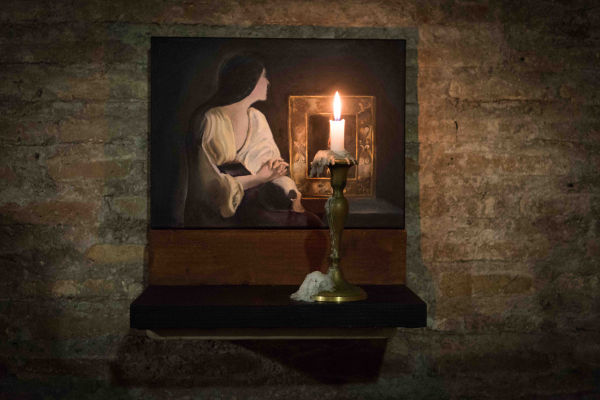"Vanity of vanities and all is vanity"
Curated by Kristien De Neve (B.A. Fine Arts), opening on March 17, 2018 and running until April 8, 2018, this new exhibition features the work of 15 women artists and is situated in the extraordinary archeological complex of the Case Romane del Celio, (the Roman Houses of Celio hill).
The exhibit is a project of the cultural organization “xcorsi d’arte” founded by De Neve. The organization offers weekly lessons for all ages and levels in the visual arts.
“My students have been working for a year on this project and my goal was to introduce them to site-specific artwork and installations” noted De Neve who has taught Sketchbook-Images of Rome and Intermediate Drawing for the last four years in AUR’s Bachelor of Fine Arts program. De Neve has also taught in Perugia in the Academy of Fine Arts as professor of multi-media art and pedagogy of art and at the Academy of Fashion, as professor of continuing education courses for art teachers. She was born in Belgium where she did her Master’s in Psychology and Pedagogical Sciences and specialized in Art Education. In Rome, she obtained a Master’s in Painting at the Academy of Fine Arts.
“From the very beginning, art and education are the two interests to which I devoted my passion and expertise”.

Exploring the theme of Vanity
“Vanitas” Latin for “vanity” is a genre of still-life painting, popular in the 16th & 17th centuries, which contains collections of objects symbolic of the inevitability of death and the transience and vanity of earthly achievements and pleasures.
In choosing the theme, the exhibition space itself was a fundamental element, said De Neve. The title of the exhibit Vanitas Vanitatum et Omnia Vanitas is Latin for “Vanity of vanities and all is vanity” and is taken from a book of Catholic wisdom, alluding to the historical significance of the setting.
The multi-layered archeological site (the burial place of the martyred saints with frescoed walls and early Christian altars) invites visitors to reflect on the passage of time and inspired the artists to express their personal statements on our fragile human existence.

You can view the digital catalogue (in Italian) with photos of the artworks displayed in the ancient rooms at https://indd.adobe.com/view/3fe87e99-ffb3-4ae8-9681-e6e54e7dd1df
You can see artworks by Professor Kristien De Neve at www.kristiendeneve.com

A beautiful setting
The Celian Roman domus, under the basilica, is located on the slopes of the Celio hill between the Colosseum and Circus Maximus. It was opened to the public in 2002.
Together with the San Clemente excavations, it offers one of the best places in Rome to see underground ruins and ancient frescos. The domus, also known as the home of the martyrs John and Paul, contains more than four centuries of history and testifies to the passage and cohabitation between paganism and Christianity. The vast frescoed rooms, originally shops and warehouses of a multi-storied popular building (insula), were in fact transformed during the 3rd century AD into an elegant domus or house.
Public Transport
Metro Line B - Circo Massimo stop
Bus - 60, 75, 81,175,673
Tram - 3
